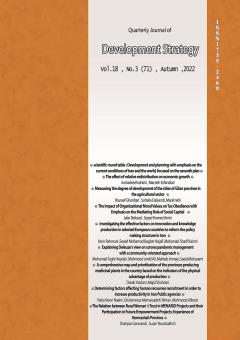-
-
List of Articles
-
Open Access Article
1 - The effect of relative redistribution on economic growth
marzieyh esfandiyari mohadeseh Rahimi -
Open Access Article
2 - Measuring the degree of development of the cities of Gilan province in the agricultural sector
Yousef ghanbari سهیلا دالوندی مارال ریاحی -
Open Access Article
3 - The Impact of Organizational Moral Values on Tax Obedience with Emphasis on the Mediating Role of Social Capital
جعفر بیک زاد سیدحامد امیری -
Open Access Article
4 - Investigating the effective factors on innovation and knowledge production in selected European countries to reform the policy making structure in Iran
َAsrin Rahmani Mohamad Sharif Karimi -
Open Access Article
5 - Explaining Deleuze's view on corona pandemic management with a community-oriented approach
mohamad taghi heydari saeed moharami MAHTAB AMRAYI محمود اميد علي -
Open Access Article
6 - A comprehensive map and prioritization of the provinces producing medicinal plants in the country based on the indicators of the physical advantage of production
darab yazdani majid shahriari -
Open Access Article
7 - Determining factors affecting human recourses recruitment in order to increase productivity in Iran Public agencies
رها نوری نائینی Gholamreza Memarzadeh Mahmood Alborzi -
Open Access Article
8 - The Relation between Rural Woman 's Trust in MENARID Projects and their Participation in Future Empowerment Projects: Experience of Kermashah Province
Susan Noorbakhsh
-
The rights to this website are owned by the Raimag Press Management System.
Copyright © 2017-2026







